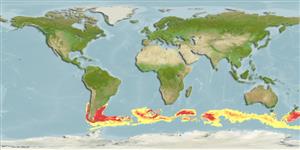Classification / Names
Common names from other countries
Référence principale
Taille / Poids / Âge
Max length : 215 cm TL mâle / non sexé; (Ref. 2121); common length : 70.0 cm TL mâle / non sexé; (Ref. 2121); poids max. publié: 9.6 kg (Ref. 58336); âge max. reporté: 31 années (Ref. 87879)
Length at first maturity
Lm ?, range 38 - 60 cm
Environnement
; marin; océanodrome (Ref. 51243); profondeur 50 - 3850 m (Ref. 11892), usually 70 - 1500 m (Ref. 2121)
Climat / Gamme
Temperate, preferred 7°C (Ref. 107945); 33°S - 66°S, 77°W - 180°E (Ref. 54228)
Distribution
Southeast Pacific and Southwest Atlantic: southern Chile round the coast to Patagonia (Argentina) and the Falkland Islands. Southwest Pacific: Macquarie Island. Southern Ocean: South Georgia. Also known from sub-Antarctic islands and seamounts of the Indian sector.
Pays | Zones FAO | Écosystèmes | Occurrences | Introductions
Description synthétique
Épines dorsales (Total): 8 - 10; Rayons mous dorsaux (Total): 28-30; Épines anales 0; Rayons mous anaux: 28 - 30; Vertèbres: 53 - 54. Lateral line scales 88-104 (upper), 61-77 (lower).
Statut dans la liste rouge de l'IUCN (Ref. 115185)
Menace pour l'homme
Harmless
Utilisations par l'homme
Pêcheries: commercial
Outils
Articles particuliers
Télécharger en XML
Sources Internet
Estimates of some properties based on models
Phylogenetic diversity index
PD50 = 0.7500 many relatives (e.g. carps) 0.5 - 2.0 few relatives (e.g. lungfishes)
Niveau trophique
4.0 ±0.68 se; Based on food items.
Résilience
Faible, temps minimum de doublement de population : 4,5 à 14 années (Fec=230,000; tmax>=21)
Vulnérabilité
High to very high vulnerability (71 of 100)
Catégorie de prix
